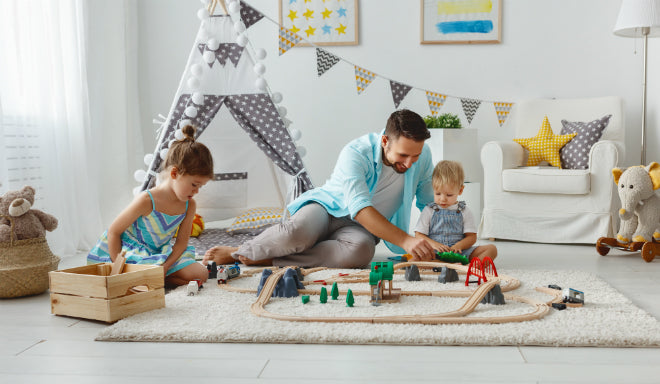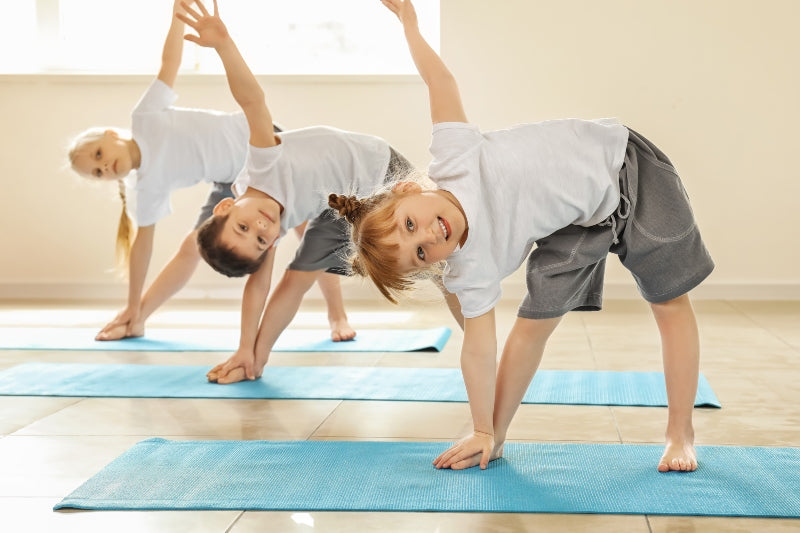" Promoting development "
In the early years, children have to learn an enormous amount and master numerous situations. To prevent this from becoming stressful for both the parents and the child, it makes sense to teach new things in a playful way. With a few small games and suitable educational toys, you can keep even the biggest learning grump happy. The positive side: motor skills and perception are trained and emotional development is encouraged. In the following lines, we will give you tips on how your toddler can learn through play. We will tell you in which areas these measures are useful and how you can support your child.
The best school for a child: everyday life
A baby is interested and curious from the very first minute of life. This unbridled urge to explore and discover is very exhausting for parents, but also enormously important for children. Everyday life holds numerous new challenges in store and babies first need to understand how different relationships work.

Children need social contact
In addition to physical development, balanced emotional development is of course also important. For this, children not only need the closest family, but contact with peers also plays a major role in this context. Babies need to get to know their feelings and develop them further, as this is the only way they will be able to cope confidently with everyday life later on. Each of us needs to gain a balance of experiences in our lives, such as sadness, happiness, contentment or despair. This is the only way we can grow into mentally stable people.
Learning through play: the best tips for playful encouragement
"Encourage and challenge" is the motto when it comes to child development. It is not uncommon for parents to have little idea what this means. Some even see this type of encouragement as pointless, as it deprives children of their carefree, precious childhood. In reality, however, "encouraging and challenging" can certainly take place in a playful context. It is then usually very easy to improve various skills while having fun.
The following five examples show that "encouraging and challenging" can be done in a relaxed way with the right educational games:
-
Jigsaw puzzles
A jigsaw puzzle is an educational toy that encourages children in many different ways. Make absolutely sure that the product is suitable for the age of your child. If it is too difficult, little ones usually lose patience quickly. If it is too easy, on the other hand, the positive learning effect and the fun are lost. An age-appropriate puzzle not only promotes motor skills and the general ability to concentrate, but also trains spatial thinking. In addition, doing puzzles often has a very relaxing effect and helps children to learn more patience.

Puzzles motivate children in their desire to learn
-
Beads and co.
As soon as the so-called tweezer grip is mastered, many children enjoy playful tasks that make them want to be creative. Craft beads made of wood, silicone or similar are ideal for learning through play. Simply give your offspring suitable threading cords and they can give free rein to their creativity. Of course, all kinds of craft materials are suitable. The little ones often spend hours with them and their fine motor skills are also trained along the way. Sticker books, weaving frames or a knitting machine can also playfully improve fine motor skills.
-
Board games
Board games are a must in every family household, as they bring the family together around the table and also prove to be good and effective development tools that do not have a classic learning character. They don't necessarily have to be typical educational games, but classics such as "Mensch ärgere Dich nicht" or "Monopoly" can also serve well here. There are different types of games in which the participants either all play against each other or together as a team. It is definitely worth trying both variants, because while team games help to improve cooperation skills and communication, a normal competitive game can promote more respectful interaction and increase frustration tolerance.
-
Painting
Creativity is important for a child's development for many reasons. Drawing and coloring help to develop the joy of experimentation, improve hand-eye coordination and fine motor skills. With different materials such as watercolors, colored pencils, stamps, wax crayons or similar, you can introduce your child to the flexibility of colors and encourage self-efficacy. Later at school, the knowledge gained through playful learning will help them to find new solutions quickly and, above all, on their own.

Encourage creativity through painting
-
Experiment kit
Experiment kits are some of the most popular educational games for young hobby scientists. These are available in many different versions so that they can be easily adapted to the age of your child. You will find all kinds of themes, so there is guaranteed to be something suitable for you: From the small garden bed or the huge chemistry lab, to growing prehistoric crabs or diamonds, to making your own "plasticine slime", there is basically nothing left to be desired. If in doubt, you should always carry out the experiments together, as some of the chemicals used are harmful. This is another reason why it is important to always follow the manufacturer's age specifications, as this is the only way to ensure that learning through play makes sense.
Encourage through music in everyday life

Music can make a significant contribution to improving language skills. It is also fun, provides relaxation and creates time together. Sing a lot with your child and let them listen to the sounds. Even the youngest children can use the rhythm to improve their memory.
Even if you yourself may think that your singing should not necessarily be heard, you should train your voice together. Show your child soft and loud sounds, high and low tones and speed up and slow down when talking. Instead of reading out a particular text, you can also simply sing it aloud. Difficult words should be stretched out as you speak, as this allows each individual sound to be heard best, which of course also makes it easier to learn the word.
Sing one or two songs in the evening and you will see how much fun you and your child will have. Your child will soon be able to sing the lyrics by heart. If certain words are associated with melodies, people can often remember them better by nature. Your little darling is also guaranteed to learn how the lyrics and the corresponding melodies are put together with ease.

You can also practise conscious listening by playing learning games: With eyes closed, the aim is to describe which sounds can be heard: Coughing from the living room, daddy's keys, honking cars, birds singing, the tap, the coffee machine, etc. To encourage rhythm and use it at the same time, you can also stomp, snap or clap syllables together to everyday objects. Sing or say rhythmic nursery rhymes frequently, as this stimulates the imagination through play and significantly improves speech.










